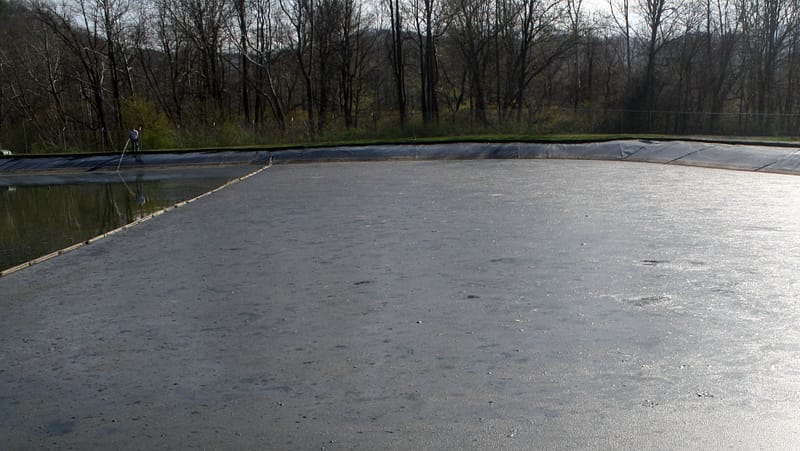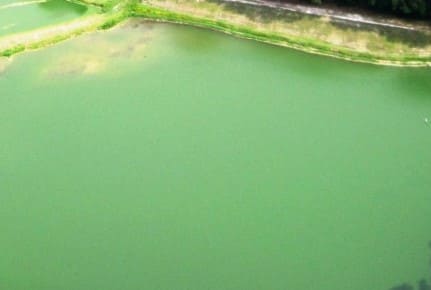Is Your Lagoon Overloaded?
Organic overloading is a common cause of wastewater lagoon effluent problems. In this article, we’ll define an overloaded lagoon and describe the problems it can cause, outline the seven signs to look for, and then offer solutions.
What Is an Overloaded Lagoon?

An overloaded lagoon is one that has exceeded its capacity, either with too much influent flow or too much Biological Oxygen Demand (BOD), exceeding the lagoon’s design parameters and leaving wastewater insufficiently treated. As the EPA describes it: “Organic overload is normally caused by influent organic shock loads or increased organic load with no corresponding increase in treatment plant capacity.” Causes of lagoon overload include an expansion of service area, with more users coming online; poor lagoon design; and high strength industrial wastes in the influent.
This overloading causes a low dissolved oxygen (DO) level, as the digesting organisms require more oxygen to consume the surge of BOD. Low DO in the lagoon triggers a cascade of problems: sludge buildup and accompanying odors; lower retention time and inhibited treatment; and high BOD effluent. Before you know it, you are out of compliance.
Already in violation of permit? Triplepoint offers aeration system rental.
Seven Signs of an Overloaded Lagoon
1. Excessive sludge: Sludge is a normal byproduct of lagoon wastewater treatment, but an optimally functioning lagoon has minimal sludge that only needs to be dealt with every few decades. The sludge is stored at the bottom of the lagoon, where it traps nutrients like nitrogen and phosphorus. However, as the lack of DO reduces treatment effectiveness, undigested BOD and TSS settle to the bottom of the lagoon, taking up valuable capacity and leading to anaerobic treatment, which is a slow, odor-generating process. Floating sludge indicates that the lagoon has turned over—the gases generated by the anaerobic digestion process have become entrained in the sludge and lifted the solids to the surface of the lagoon. For more on lagoon turnover, see our article, How to Prevent Spring Lagoon Turnover and Odors.
2. Odors: As the gases released by anaerobic digestion bubble to the surface, noxious, sulfurous compounds are released all at once. Additionally, the floating sludge will continue to break down, creating even more odors as it has no water cap over it to keep odors at bay.

3. Color changes: In What color is your wastewater lagoon?, we describe several common wastewater lagoon colors and what they indicate about lagoon health. Generally, any water condition besides clear sparkling blue, green, or brown indicates low DO, with excess algae, nutrients, or too many of the wrong kind of organisms the culprit.
4. Low DO: if your lagoon has a DO level of less than 0.5 mg/L, this can be an indication that lagoon lacks the oxygenation required to aerobically digest waste and control odors.
5. High BOD effluent: A high effluent BOD level indicates that wastewater is being undertreated.
6. High lagoon ammonia: High nutrient levels can either be caused by influent ammonia and phosphorus not being sufficiently treated, or by benthal feedback, when lagoon turnover frees the nutrients that were trapped in the sludge. This nutrient release further feeds algae, spiking BOD and TSS levels. Triplepoint’s NitrOx® Process can provide cost-effective lagoon ammonia treatment within your existing infrastructure.
7. Falling pH: Overloading causes pH levels to drop. Wastewater lagoon microbes do their best work when pH levels are on the base to alkaline side—between 6.5 to 9—so any pH outside of that range leads to a reduction in both aerobic and anaerobic treatment, further encouraging sludge buildup. A high pH discourages odors from forming, destroys some pathogens, and assists in the volatilization of ammonia.
How to Correct an Overloaded Lagoon
According to the EPA’s Principles of Design and Operations of Wastewater Treatment Pond Systems for Plant Operators, Engineers and Managers, “The immediate solution [to overloading] is to increase organic treatment capacity by increasing aeration.”
Ares Aeration® Prevents Wastewater Lagoon Overload
An aerated and mixed wastewater lagoon can handle shock loads; prevent algae growth, sludge buildup, and odors; and ensure effective treatment. Triplepoint’s Ares aeration provides both aeration and mixing.
The Ares Lagoon Aeration System combines the mixing advantages of lagoon coarse bubble diffusers to keep solids in suspension with the efficiency of fine bubble diffusers for superior oxygenation in a high flexibility, low maintenance, portable unit. For more information, download our Ares Aeration Literature or contact us and we will be happy to help you with your lagoon aeration project.
